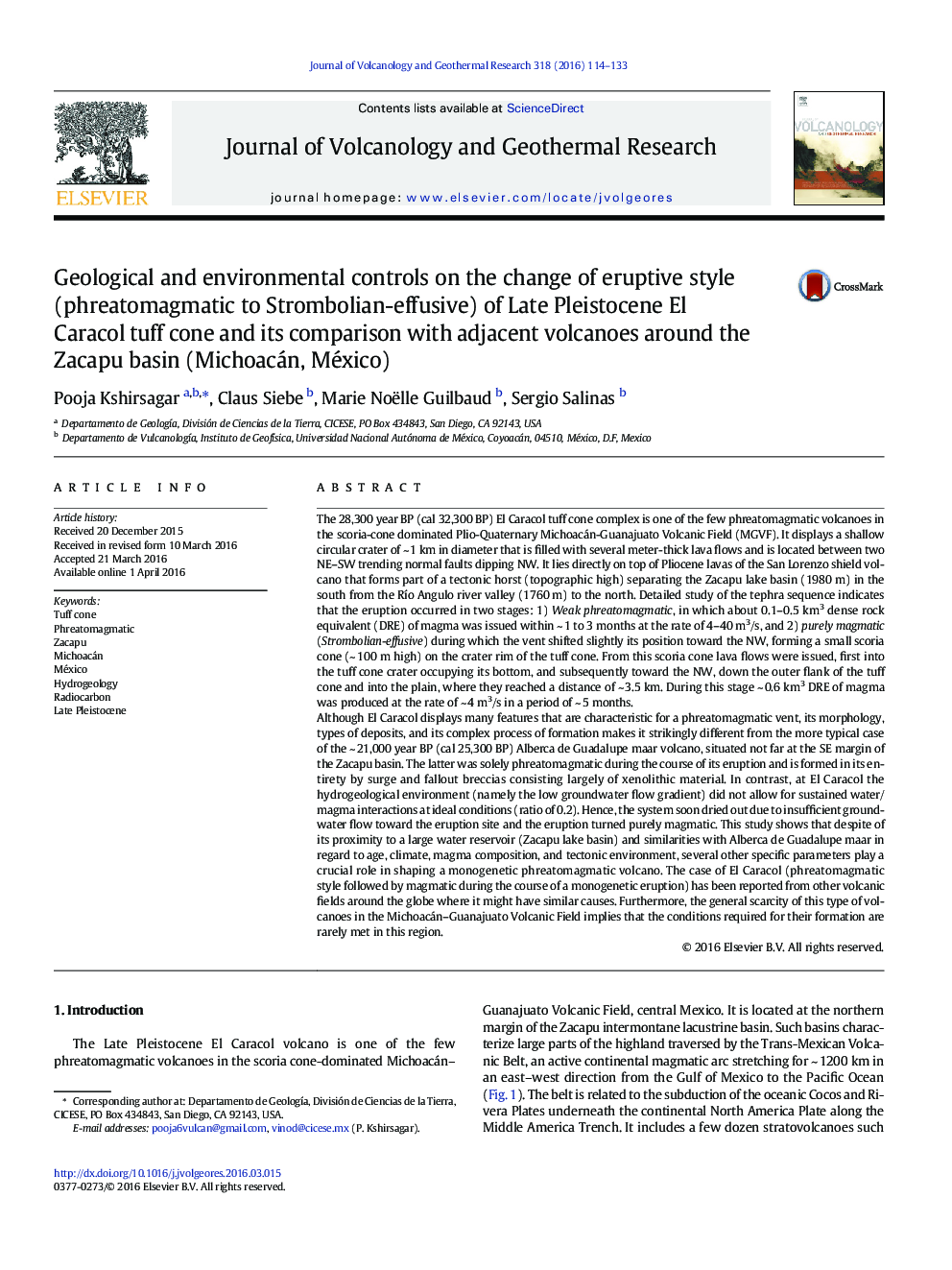| کد مقاله | کد نشریه | سال انتشار | مقاله انگلیسی | نسخه تمام متن |
|---|---|---|---|---|
| 4712705 | 1638304 | 2016 | 20 صفحه PDF | دانلود رایگان |

• We identify a tuff cone complex amid of a scoria cone dominated MGVF.
• We study its morphology, tectonic configuration and sedimentological characteristics of the deposits.
• The system fails to achieve optimal water–magma ratio due to high magma flux and hardly-sufficient water supply conditions.
• The eruption style changes from Surtseyan/weak phreatomagmatic to fully magmatic (Strombolian to effusive).
The 28,300 year BP (cal 32,300 BP) El Caracol tuff cone complex is one of the few phreatomagmatic volcanoes in the scoria-cone dominated Plio-Quaternary Michoacán-Guanajuato Volcanic Field (MGVF). It displays a shallow circular crater of ~ 1 km in diameter that is filled with several meter-thick lava flows and is located between two NE–SW trending normal faults dipping NW. It lies directly on top of Pliocene lavas of the San Lorenzo shield volcano that forms part of a tectonic horst (topographic high) separating the Zacapu lake basin (1980 m) in the south from the Río Angulo river valley (1760 m) to the north. Detailed study of the tephra sequence indicates that the eruption occurred in two stages: 1) Weak phreatomagmatic, in which about 0.1–0.5 km3 dense rock equivalent (DRE) of magma was issued within ~ 1 to 3 months at the rate of 4–40 m3/s, and 2) purely magmatic (Strombolian-effusive) during which the vent shifted slightly its position toward the NW, forming a small scoria cone (~ 100 m high) on the crater rim of the tuff cone. From this scoria cone lava flows were issued, first into the tuff cone crater occupying its bottom, and subsequently toward the NW, down the outer flank of the tuff cone and into the plain, where they reached a distance of ~ 3.5 km. During this stage ~ 0.6 km3 DRE of magma was produced at the rate of ~ 4 m3/s in a period of ~ 5 months.Although El Caracol displays many features that are characteristic for a phreatomagmatic vent, its morphology, types of deposits, and its complex process of formation makes it strikingly different from the more typical case of the ~ 21,000 year BP (cal 25,300 BP) Alberca de Guadalupe maar volcano, situated not far at the SE margin of the Zacapu basin. The latter was solely phreatomagmatic during the course of its eruption and is formed in its entirety by surge and fallout breccias consisting largely of xenolithic material. In contrast, at El Caracol the hydrogeological environment (namely the low groundwater flow gradient) did not allow for sustained water/magma interactions at ideal conditions (ratio of 0.2). Hence, the system soon dried out due to insufficient groundwater flow toward the eruption site and the eruption turned purely magmatic. This study shows that despite of its proximity to a large water reservoir (Zacapu lake basin) and similarities with Alberca de Guadalupe maar in regard to age, climate, magma composition, and tectonic environment, several other specific parameters play a crucial role in shaping a monogenetic phreatomagmatic volcano. The case of El Caracol (phreatomagmatic style followed by magmatic during the course of a monogenetic eruption) has been reported from other volcanic fields around the globe where it might have similar causes. Furthermore, the general scarcity of this type of volcanoes in the Michoacán–Guanajuato Volcanic Field implies that the conditions required for their formation are rarely met in this region.
Journal: Journal of Volcanology and Geothermal Research - Volume 318, 15 May 2016, Pages 114–133